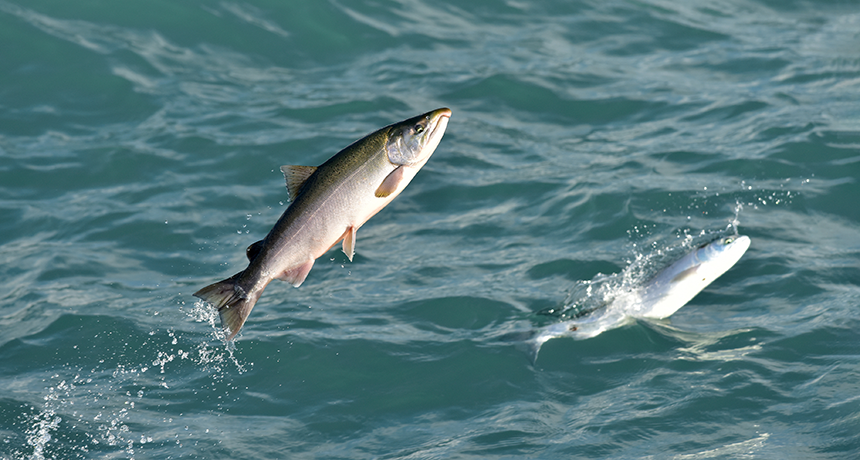Is ocean acidification knocking the scents out of salmon?
In more acidic water, the smell of danger doesn’t trigger salmon’s fear factor like it should

A salmon’s sense of smell is critical for its survival. But rising acidity in the world’s oceans could hamper the fish’s ability to detect danger, a new study finds.
John Pennell/iStockphoto
By Beth Geiger
Salmon’s ability to sniff out danger seems to nosedive as seawater becomes more acidic. That’s the finding of a new study. It assessed the fear response of salmon at different levels of pH. That’s the scale that ranks how acidic or alkaline something is.
Human activities have been adding more and more carbon dioxide, or CO2, to the atmosphere. This has been causing global warming. But not all of the CO2 emitted stays in the air. The world’s oceans absorb some of it. That, in turn, has been lowering the water’s pH, a process known as acidification (Ah-SID-ih-fih-KAY-shun).
Chase Williams is a toxicologist at the University of Washington in Seattle. Such scientists study how chemicals and other things might cause harm. Williams and his colleagues knew that a lot of research had linked lower pH to altering smell-based behaviors of tropical fish. They wanted to probe for similar impacts in salmon, a species that many people eat.
“Salmon rely heavily on their sense of smell for survival and successful reproduction. So it was important to investigate how low-pH water might impact their sense of smell,” he explains.
Williams and his team tested coho salmon in the lab living in water with different pH levels. And the more acidic the water, the less the fish fled the smell of danger, the researchers now report. They shared their findings December 18, 2018 in Global Change Biology.
Fear factor
“The smell of salmon skin should set up major alarms in a salmon’s brain. It warns them that their school mate is being eaten,” Williams says. “You can imagine that’s very powerful in the wild.” Normally, one whiff of salmon skin will send other fish scurrying for safer waters.
For their new tests, the researchers placed eight young coho salmon in each of three separate tanks. Then they gave the fish 14 days to get used to the ocean water, which had been harvested from nearby Puget Sound. It’s the large saltwater body in western Washington through which adult coho pass on their way to the Pacific Ocean.
One tank was a control. It contained water with a pH of 7.8. That is the natural average pH in Puget Sound. The second tank contained water with a pH of 7.5, making it slightly more acidic. That is also the projected pH of Puget Sound in 50 years, if CO2 emissions continue to rise. The third tank contained water with a pH of 7.2. That’s the projected pH in Puget Sound a century from now.
After two weeks, the researchers pumped an “alarm scent” laced with salmon skin extract into each tank.
Fish in the control tank fled the alarm scent, as expected. They spent 80 percent of their time in a “safe” portion of the tank. But fish didn’t seem to care where they hung out in the tank with the most acidic pH. “In other words,” said Williams, “they were indifferent to the alarm odor.”
The team then analyzed olfactory (scent) receptors in the cohos’ noses and brains. “We found no real signal interference in the nose,” said Williams. “But the way the brain is processing [the signal] seems different.”
Put simply: The salmon no longer recognized that the smell meant danger.
Upstream battle
Salmon depend on smell for more than evading predators. Like most salmon species, coho are anadromous. That means that they hatch and grow in freshwater rivers, then migrate to the sea as they mature. At the end of their lives, the salmon return to the streams of their birth. They fight their way there to spawn — then die.
Smell is critical for these fish finding their way back to “home” streams to reproduce. It’s also crucial for identifying other coho, including potential mates.
The results of the new study don’t bode well for these fish, Williams says. Already, he notes, these fish and their ecosystems face a host of other pressures. Dams on some rivers, for instance, make it difficult for coho to return to spawn in their home streams. And even should they make it upstream to spawn, dams might kill young coho as they tried to migrate downstream to the sea. Polluted storm water flowing into Puget Sound is also proving toxic to these fish.
James Helfield agrees that the study is bad news for coho. He is a fisheries biologist at Western Washington University, in Bellingham. Helfield studies salmon ecology but was not involved in the study. “This study illustrates another way that climate change might harm salmon populations,” he says.
In many waters, salmon are more than just another fish in the sea. In the ocean, they provide essential food for other species, including seals, orcas, other fish species and, of course, people. In rivers, they have a trickle-up effect on the food web and the ecosystem. Once salmon die in those rivers, their decaying bodies add nutrients to the forest.
And what’s bad news for salmon is probably bad news for other marine species, too. In fact, says Helfield, the study’s findings are not unexpected. “Other recent studies,” he notes, “have shown that some marine fish become ‘drunk and disoriented’ when exposed to too much carbon dioxide in sea water.”







